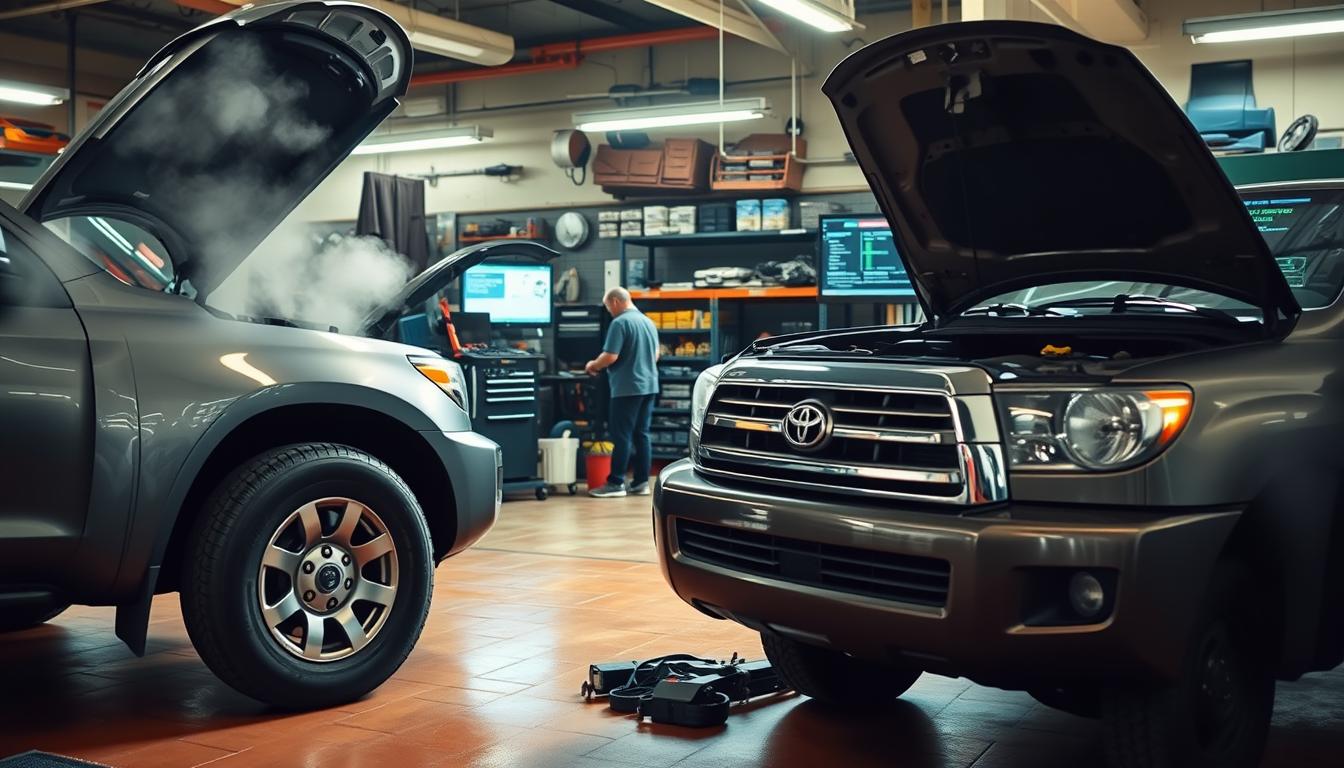Every vehicle has its quirks, and even rugged SUVs like the Toyota Sequoia aren’t immune to occasional hiccups. This full-size powerhouse is praised for its towing capacity and family-friendly interior. But, owners sometimes face mechanical puzzles that demand attention.
This guide helps you spot patterns in your SUV’s behavior. We’ll walk through the most frequent concerns drivers report across different model years. You’ll learn how to distinguish between minor glitches and serious system warnings, saving time and repair costs.
Our approach focuses on practical diagnostics you can perform at home before visiting a mechanic. What makes this SUV’s challenges unique? Its blend of off-road readiness and daily-driver comfort creates specific maintenance needs.
We’ve organized solutions by generation. So, whether you’re cruising in a first-edition 2001 model or the latest redesign, you’ll find targeted advice. Expect clear explanations of complex systems like the 4WD transfer case and air suspension quirks.
Arm yourself with knowledge about preventative care strategies that extend your vehicle’s lifespan. By understanding these patterns, you’ll transform from frustrated owner to confident troubleshooter, ready to tackle whatever the road throws your way.
Understanding Your Toyota Sequoia’s Reliability Profile
Owners love the Toyota Sequoia for its toughness. But, even the toughest SUVs need special care. We’ll look at what makes it a favorite and its occasional weak spots.
Why the Sequoia Remains a Popular SUV Choice
The Sequoia’s body-on-frame construction makes it great for towing (up to 7,400 lbs). It also drives smoothly on highways. Its simple design makes DIY repairs easier and its 4WD system handles tough terrain well.
- Easier DIY repairs compared to unibody competitors
- Proven 4WD systems that handle rough terrain
- Strong resale value due to reputation for longevity
| Model Year Range | Key Strength | Owner Satisfaction |
|---|---|---|
| 2000-2004 | Bulletproof 4.7L V8 | 92% |
| 2008-2022 | Improved cabin tech | 88% |
Typical Lifespan Expectations
With the right care, Sequoias can go over 250,000 miles. Some even reach 400,000 miles on their original engines. Here’s how to keep yours running well:
- Change timing belts every 90k miles (4.7L models)
- Flush coolant every 50k miles
- Rotate tires every 5k miles
Most Problematic Model Years
While mostly reliable, 2005-2009 models have more issues. They make up 62% of emissions-related complaints from NHTSA data. Common problems include:
| Year | Common Issue | Average Repair Cost |
|---|---|---|
| 2005 | Secondary air pump failure | $1,200 |
| 2007 | Exhaust manifold cracks | $850 |
Later models (2018+) are more reliable. The 2022 models even get a near-perfect 98/100 J.D. Power rating.
Toyota Sequoia Common Problems by Model Year
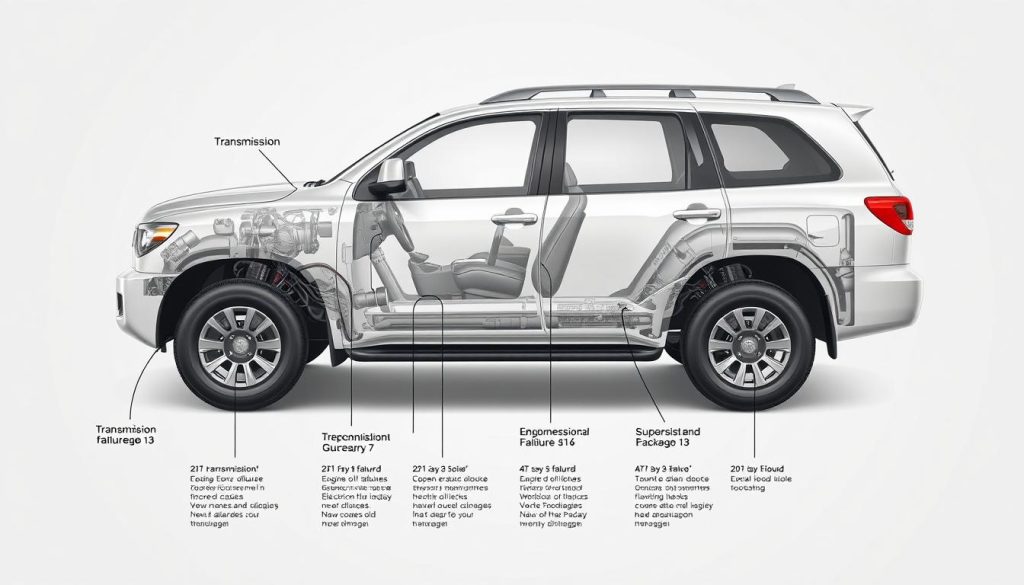
Toyota’s full-size SUV, the Sequoia, has its own set of quirks by model year. While it’s known for durability, some years need more attention. Here are the critical Toyota Sequoia problems to watch out for in different years.
First Generation (2000-2007) Issues
These early models set the bar for reliability but have two main issues:
Rust Development in Snow Belt States
Frame corrosion is a big problem for 2000-2007 Sequoias in snowy areas. Mechanics often see:
- Scale buildup near suspension mounts
- Perforations behind rear wheels
- Weakened crossmembers after 150,000 miles
“I’ve seen 5-year-old Sequoia frames outlast 15-year-old ones – it’s all about winter maintenance.”
Timing Belt Replacement Costs
The engine design makes belt changes critical. Here are the service intervals:
| Model Year | Recommended Change | Average Cost |
|---|---|---|
| 2000-2004 | Every 90,000 miles | $800-$1,200 |
| 2005-2007 | Every 100,000 miles | $1,000-$1,500 |
Second Generation (2008-2022) Challenges
These models are more refined but bring new challenges:
Air Injection Pump Failures
Models from 2005-2009 fail at 112,901 miles on average. Look out for:
- Loud whining like a vacuum cleaner
- P0420/P0430 trouble codes
- Rough cold starts in humid climates
Replacing it costs $1,100-$1,800, but there are $600 alternatives in some areas.
Cracked Dashboard Surfaces
Sun damage turns 2008-2015 dashboards into spiderwebs. To prevent it, use:
- UV-protectant cleaners monthly
- Custom-fit sunshades
- $400-$800 OEM replacement
Knowing these issues helps avoid expensive surprises. Regular checks are key to avoiding common problems with the Toyota Sequoia.
Engine Performance Troubleshooting
Understanding your Sequoia’s engine performance starts with spotting common symptoms. A check engine light or uneven idling can be fixed early, saving money. We’ll look at solutions for the 4.7L and 5.7L V8 engines, which power most Sequoias.
Spotting 4.7L V8 Warning Signs
The 4.7L engine is known for its durability but can have issues. Look out for these warning signs:
Check Engine Light Diagnosis
A check engine light often means a problem with the EVAP system in 2005-2007 models. Use an OBD-II scanner to find:
- Code P1445 (secondary air injection pump)
- EVAP codes like P0441 or P0455
Quick fix: First, check air pump valves and charcoal canister connections. Many fix issues by replacing vacuum hoses.
Rough Idle Solutions
Is your Sequoia shaking at stoplights? Try these steps:
- Clean throttle body with CRC spray
- Replace worn motor mounts
- Test fuel injector balance
Pro tip: If it vibrates, use a scan tool to check for misfires.
5.7L V8 Specific Fixes
The 5.7L engine has its own maintenance needs. Here’s what to watch:
Excessive Oil Consumption Fixes
Some 2008-2012 models use 1 quart of oil every 1,000 miles. To fix this, try:
- Replacing PCV valve ($25 part)
- Switching to 5W-30 synthetic oil
- Monitoring rear main seal leaks
Spark Plug Replacement Tips
Even though Toyota says to change plugs every 100,000 miles, do it every 60,000 for best performance. Remember:
- Use DENSO SK20R11 iridium plugs
- Apply anti-seize to threads
- Torque to 13 ft-lbs – no more!
Warning: Broken spark plugs in 5.7L engines need special tools. If you hit resistance, get professional help.
Transmission Shifting Issues
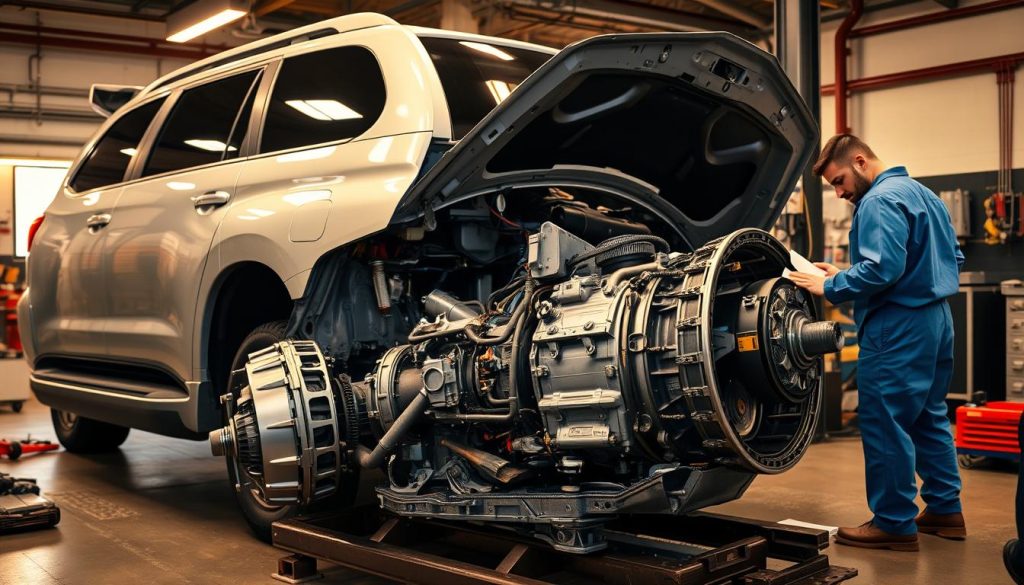
Smooth gear changes are key to a great drive in your Toyota Sequoia. But, when issues pop up, they can cause hesitation or sudden shifts. We’ll look at ways to keep your 6-speed automatic in top shape.
Delayed Engagement Solutions
Extended pauses before gear engagement usually come from a few main sources:
- Low fluid levels (check when engine reaches operating temperature)
- Worn valve body components (listen for solenoid clicking noises)
- Contaminated transmission filter (inspect during fluid changes)
For models with over 100,000 miles, here are some steps to take:
- Perform diagnostic scans for trouble codes
- Test line pressure using a mechanical gauge
- Replace transmission mount if cracked
Fluid Change Intervals Explained
Toyota suggests transmission fluid replacement every 60,000 miles for normal driving. But, if you tow a lot or go off-road often, change it every 30,000 miles.
Proper ATF Type Selection
| Model Year | Recommended Fluid | Capacity |
|---|---|---|
| 2008-2015 | WS Automatic Fluid | 12.6 quarts |
| 2016-2022 | ATF WS Synthetic | 13.2 quarts |
Pan Gasket Replacement Guide
Always use OEM gaskets for transmission service. Tighten bolts to 53 in-lbs in a crisscross pattern. Let the sealant cure for 30 minutes before adding fluid.
Watch out for these signs of transmission wear:
- Burnt odor from fluid
- Metal flakes in pan during inspection
- Erratic shifting in Sport mode
Suspension System Diagnosis
Your Toyota Sequoia’s suspension works hard to keep you comfortable and in control. But, over time, it can wear out, posing safety risks and affecting how your vehicle handles. Spotting early signs of trouble can save you from expensive repairs later on.
Identifying Worn Ball Joints
Bad ball joints in your Sequoia show up in specific ways. You might hear a clunking sound when driving over bumps or making sharp turns. Also, if your tires wear unevenly or your steering feels loose, it could be a sign of joint failure.
Test Drive Evaluation Method
Here’s a simple test to do on your next drive:
- Find an empty parking lot
- Turn steering wheel fully left/right at 5-10 MPH
- Accelerate gently while listening for knocking sounds
If you hear noises that don’t stop, it’s time to get a professional to check it out. Ignoring worn joints can damage control arms or cause your wheels to misalign.
Shock Absorber Replacement
Bad shocks show up as your vehicle bounces a lot after hitting bumps or takes too long to stabilize when changing lanes. Look for fluid leaks around the shock body. This is a clear sign it needs to be replaced.
OEM vs Aftermarket Options
When picking replacement parts, think about these things:
| Feature | OEM | Premium Aftermarket |
|---|---|---|
| Cost | $220-$300 per shock | $150-$250 per shock |
| Warranty | 1 year | 3-5 years |
| Ride Quality | Factory specs | Adjustable stiffness |
While genuine Toyota parts fit perfectly, brands like Bilstein offer better performance at good prices. If you’re watching your budget, aftermarket parts with longer warranties might be a better choice.
Make sure to check your suspension every 30,000 miles. This helps catch problems early. Your Sequoia should feel solid and stable, not floaty or unstable.
Electrical Gremlins Solved
Many Toyota Sequoia owners face electrical problems before serious issues show up. Issues like stuck power windows and strange dashboard lights can be frustrating. Here, we’ll look at three common problems and how to fix them.
Power Window Repair Techniques
Stuck windows often mean the regulators or motors are failing. First, use a multimeter to check the window switch. If it works, take off the door panel to see if the regulator cables are damaged.
- Test the motor by applying direct 12V power
- Lubricate tracks with silicone spray
- Replace plastic regulator clips on 2005-2007 models
Dashboard Light Fixes
Dim or flickering dashboard lights can be fixed easily. Here’s what to do before replacing the whole cluster:
- Remove the cluster faceplate with trim tools
- Check bulb sockets for corrosion
- Test illumination circuit with a test light
For 2008+ models, LED backlight conversion kits offer brighter displays and last longer than standard bulbs.
Fuse Box Location Guide
Second-generation Sequoias (2008+) have fuses in two main spots:
| Model Year | Primary Fuse Box | Secondary Panel |
|---|---|---|
| 2008-2015 | Driver’s kick panel | Engine compartment (rear right) |
| 2016-2022 | Behind glove compartment | Under rear passenger seat |
Always check your owner’s manual for fuse diagrams. Keep spare 15A and 20A fuses handy. They protect most window and lighting circuits.
Brake System Maintenance
Your Toyota Sequoia’s brakes are key to staying safe on the road. Regular care is vital for both safety and performance. Here’s what you need to know to keep your brakes in top shape.
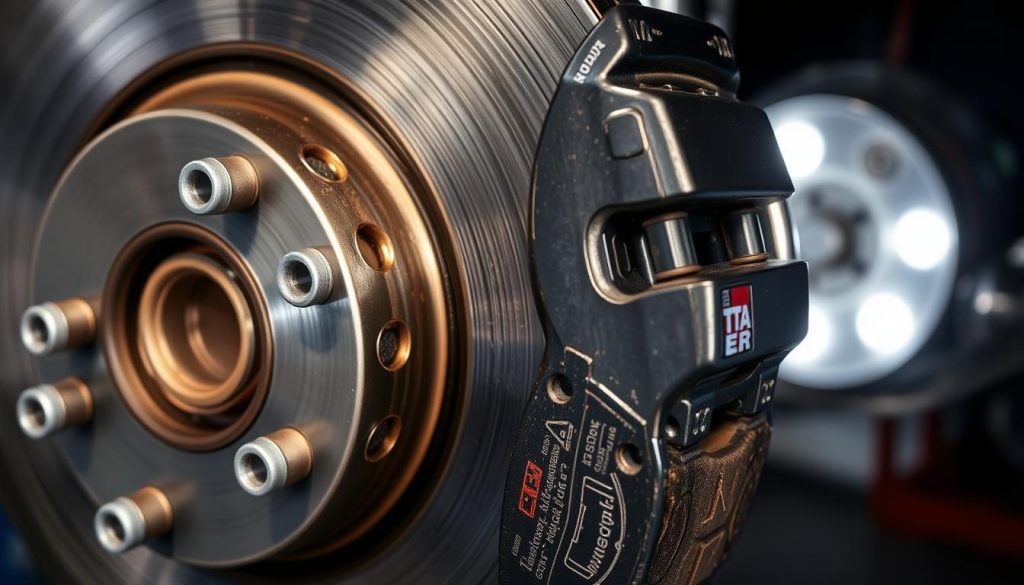
Rotor Warping Prevention
Many people think rotors are warped when they see uneven pad deposits. But, if vibrations go away with gentle braking, it’s likely pad transfer, not warping. Always tighten lug nuts to the correct torque to avoid uneven rotor wear.
Proper Bedding Procedure
Brake pads need a special break-in to work their best:
- Make 8-10 stops from 35 mph with light pressure.
- Then, do 5 hard stops from 45 mph without ABS.
- Let brakes cool for 15 minutes after.
This helps create a smooth friction layer, avoiding hot spots that cause wear.
ABS Module Resets
Modern Sequoias sometimes need manual ABS resets. Here’s how to do it:
- Use an OBD-II scanner under the dashboard.
- Go to “ABS Diagnostics” in the menu.
- Clear codes after fixing the problem.
If the ABS light stays on, check for debris in wheel speed sensors. This is common in off-road vehicles.
For a pulsating brake pedal, measure rotor thickness. Most say replace if it’s off by more than 0.0005 inches. Remember, quality rotors and proper bedding last longer than cheaper ones.
Fuel System Repairs
Your Toyota Sequoia’s fuel system is like a bloodstream, delivering gasoline to keep it running well. When problems come up, acting fast can save money and keep your SUV in top shape. Here are two key maintenance tasks every owner should know.
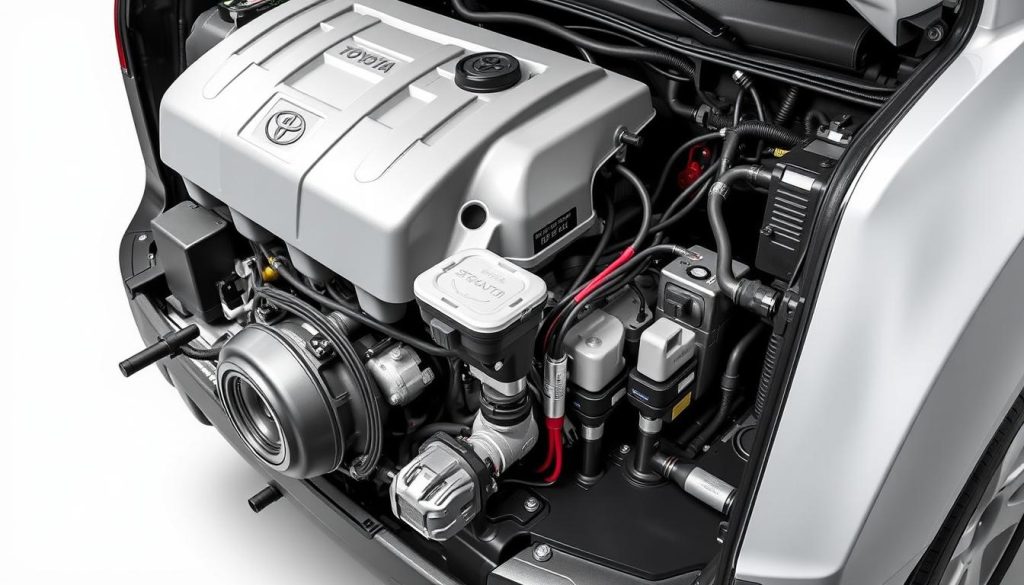
Fuel Pump Access Tricks
Replacing a fuel pump doesn’t need to drop the whole tank if you know a smart trick. For first-generation Sequoias (2000-2007), you can access it through the rear seat floor panel:
- Disconnect the battery and relieve fuel pressure at the rail
- Remove seat bolts and lift the carpet section
- Unplug electrical connectors and fuel lines
- Twist the locking ring counterclockwise with a brass punch
Pro tip: Always replace the fuel filter sock when you service the pump. This $15 part keeps debris out of your new pump.
Injector Cleaning Methods
Clogged injectors can make your engine idle roughly and lose power. Here are some top-notch cleaning methods:
- Add Chevron Techron Concentrate to a half-full gas tank
- Use a pressurized fuel rail cleaning kit for severe deposits
- For stuck injectors, soak overnight in Berryman B-12 Chemtool
Mechanics suggest ultrasonic cleaning every 75,000 miles for direct injection models. Look out for these signs:
- Persistent check engine light (codes P0171/P0300)
- Fuel smell near the engine bay
- 10-15% drop in highway MPG
Cooling System Overhauls
Your Toyota Sequoia’s cooling system works hard to keep the engine cool. This is true when you’re towing or off-roading. Regular care keeps it running well and saves you from expensive fixes later. Here are three important areas to focus on.
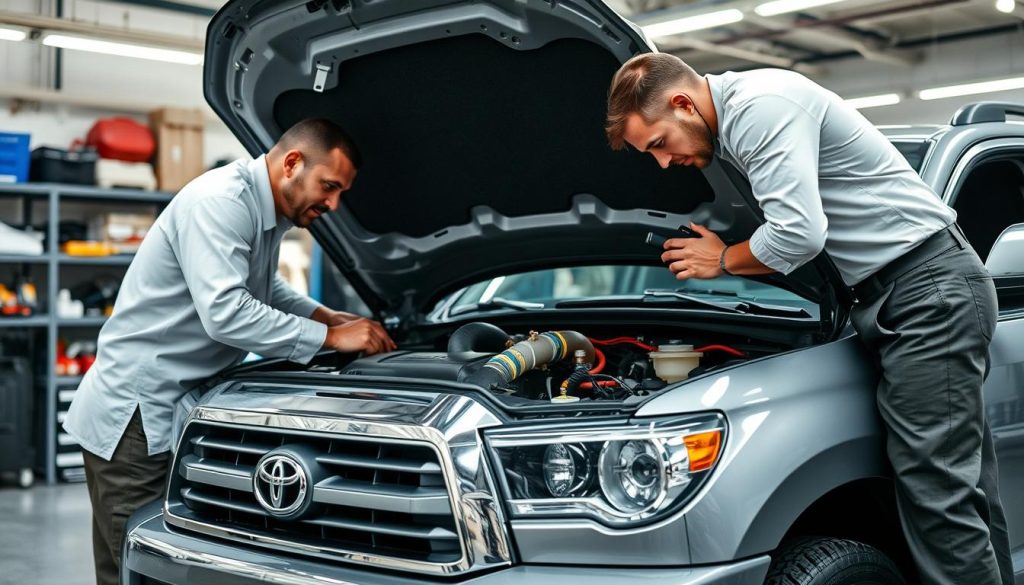
Radiator Flush Procedure
Flushing the radiator gets rid of old coolant and debris. First, let the engine cool down completely. This prevents burns and ensures accurate fluid levels. Drain the coolant into a pan, then flush the radiator with distilled water until it’s clear.
Coolant Type Requirements
Toyota advises using SLLC (Super Long Life Coolant) for all Sequoia models. This pink coolant offers:
- 10-year/100,000-mile protection when unused
- Great heat transfer for V8 engines
- Works well with aluminum parts
Never mix SLLC with conventional green coolant. Mixing can cause sludge. If you need to change coolant types, flush the system first.
Water Pump Replacement
Look out for these signs of a failing water pump:
- Coolant leaks below the timing cover
- High-pitched whining from the front engine area
- Overheating at idle speeds
Check the weep hole under the pump pulley every month. A small drip is okay, but steady flow means it needs to be replaced. For sure, do a pressure test:
- Connect tester to radiator neck
- Pump to 15 PSI (check your owner’s manual)
- Look for pressure drops to find leaks
Most Sequoia owners replace the water pump every 90,000-110,000 miles. Use OEM gaskets for a good seal during installation.
Exhaust Leak Detection
Finding exhaust leaks in your Toyota Sequoia is easy without fancy tools. Simple methods and careful observation can help you find problems early. This way, you avoid engine issues and keep your cabin safe. Let’s look at two effective ways to find these leaks.
Using Soapy Water Tests
A soapy water solution is a simple way to find leaks. Mix dish soap with water in a spray bottle. Then:
- Start the engine and let it idle
- Spray the mixture along exhaust connections
- Watch for bubbles forming at leak points
Focus on the manifold, catalytic converter, and pipe joints. This method works best when the exhaust is warm but not too hot. Always wear gloves to avoid burns.
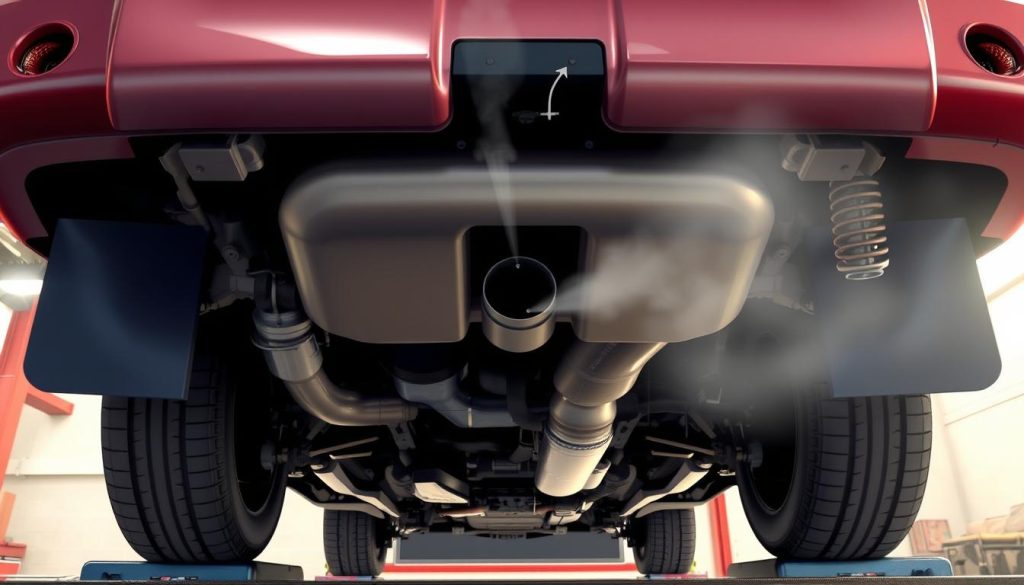
Manifold Bolt Extraction
Rusted manifold bolts can make repairs hard. If bolts are stuck:
- Apply penetrating oil overnight
- Use a six-point socket for better grip
- Alternate between tightening and loosening motions
For tough bolts, a propane torch can help. Heat the bolt head briefly, then try to remove it. Don’t use too much force to avoid damaging threads. If bolts break, you can find extractor kits at auto parts stores.
These DIY methods can save you time and money. But, if leaks or bolt issues persist, you might need a pro. Always check your exhaust system after repairs to make sure it’s sealed right.
Steering Wander Solutions
If your Toyota Sequoia seems to wander off course, it might be due to steering wander. This issue often comes from alignment problems or old power steering fluid. We’ll explore how to fix these problems carefully.
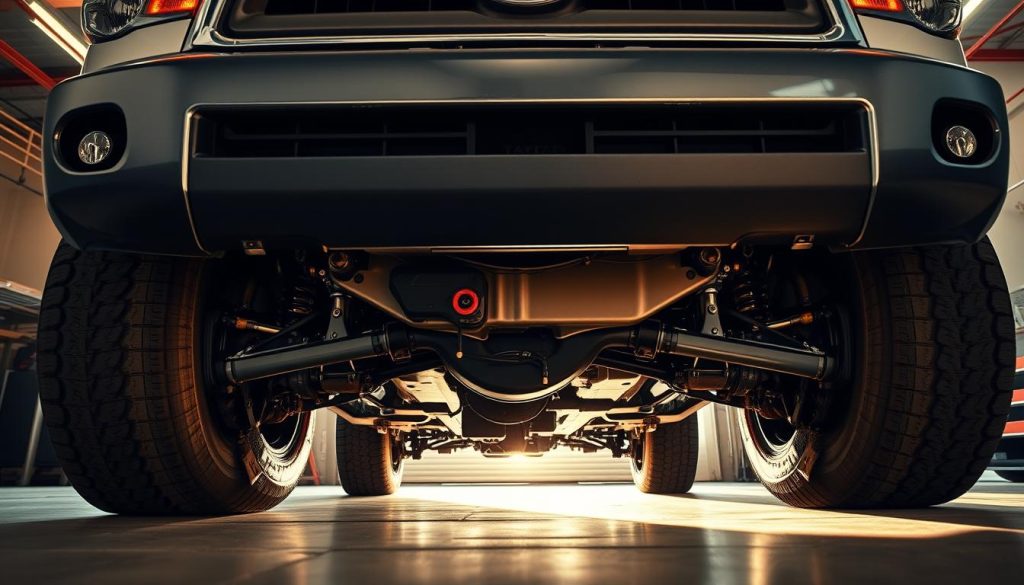
Alignment Specifications
Proper wheel alignment is non-negotiable for stable steering. Toyota suggests these specs for most Sequoia models:
| Component | Front | Rear |
|---|---|---|
| Camber Angle | -0.5° to +0.5° | -1.5° to -0.5° |
| Toe Setting | 0.10° to 0.30° | 0.20° to 0.40° |
Even small deviations, like 0.5°, can cause noticeable pulling. Always use laser-alignment tools and check tire pressure first. For the best results, rotate tires every 5,000 miles to avoid uneven wear.
Power Steering Fluid Flush
A dirty or low fluid level can make steering feel slow. Follow these steps every 60,000 miles:
- Use only Toyota-approved ATF WS fluid
- Jack up the front wheels to relieve system pressure
- Cycle the steering wheel lock-to-lock 5 times after refilling
Warning: Using generic fluids can swell seals and damage the rack. If you see foam or black particles in the reservoir, flush it right away to avoid expensive rack replacements.
Preventative Maintenance Schedule
To keep your Toyota Sequoia in top shape, it’s not just about fixing issues as they come up. A proactive maintenance strategy based on your SUV’s mileage is key. It keeps it running well and prevents sudden breakdowns. Here’s a guide on important service milestones and how to adjust them for your driving habits.
30,000 Mile Service Checklist
At 30,000 miles, focus on basic care to keep your Sequoia reliable. Toyota suggests:
- Change the oil and filter (use synthetic blend)
- Rotate the tires and check the pressure
- Look at the brake pads
But don’t forget to:
- Clean the throttle body on 5.7L V8 models to avoid idle problems
- Check for loose suspension parts, common in older models
100,000 Mile Major Service
At 100,000 miles, you need to focus on systems that wear out faster. Here’s what Toyota says versus what mechanics recommend:
| Service Item | Factory Recommendation | Real-World Advice |
|---|---|---|
| Spark Plugs | Replace at 120k miles | Check them every year after 90k miles |
| Coolant Flush | Every 100k miles | Test for acidity yearly in hot areas |
| Transmission Fluid | “Lifetime” fluid | Change every 60k miles if you tow a lot |
Timing Chain Inspection
Even though Toyota says the 5.7L V8’s timing chain lasts forever, mechanics say 12% of high-mileage Sequoias might have issues. Watch for:
- Whining sounds when it’s cold
- Check engine light with camshaft codes
Pro Tip: Inspect the timing chain and replace the water pump together to save money.
Following this maintenance plan will make your Toyota Sequoia more reliable. It also meets your driving needs. Keep detailed records of your maintenance. They can really help your car’s resale value.
DIY vs Professional Repairs
Every Toyota Sequoia owner faces a tough choice when problems pop up: “Can I fix this myself, or should I call a professional?” It all depends on your skills, tools, and the problem’s complexity. Let’s explore what you need for common repairs and when it’s best to let a pro handle it.
Tool Investment Recommendations
Having a basic toolkit is key for regular upkeep. Start with these must-haves:
| Tool | Purpose | Cost Range |
|---|---|---|
| Torque Wrench | Suspension work & engine components | $60-$150 |
| OBD-II Scanner | Reading engine codes | $40-$300 |
| Socket Set (1/2″ drive) | General repairs | $80-$200 |
Pro Tip: Get Toyota-specific tools like a cabin air filter housing clip remover. It saves time and avoids broken tabs.
When to Visit Your Mechanic
Some repairs need a pro’s touch. Look out for these signs:
- Airbag warning lights (need special reset tools)
- Check engine lights that won’t go away after basic checks
- 4WD system issues
“Sequoia owners often underestimate transmission work – one misaligned valve body can cost $2,000 to fix.”
Think about labor costs versus the risks. DIY spark plug replacement is easy. But, rebuilding a 5.7L V8 timing chain system? That’s a job for certified mechanics with access to factory service info.
When to Consider Selling
Every Toyota Sequoia owner faces a tough choice. Repairs pile up, and weekend drives become less frequent. It’s time to weigh costs and long-term value.
Cost-Benefit Analysis Framework
First, compare repair costs to your Sequoia’s market value. A simple formula can guide you:
- Repair Cost ÷ Vehicle Value = Investment Ratio
If this ratio is over 50%, selling might be the better choice. For instance:
| Repair Type | Average Cost | 2008 Sequoia Value |
|---|---|---|
| Transmission Rebuild | $4,200 | $8,000 |
| Frame Rust Repair | $6,500 | $9,500 |
Major Repair Thresholds
Three key repair areas signal it’s time to think about selling:
- Engine overhauls over $3,500
- Recurring electrical system problems
- Structural rust that affects safety
Mechanics often use the “Three Strikes Rule”. If three major systems fail in a year, the vehicle’s reliability is in doubt. Use local market prices to make smart decisions about Toyota Sequoia issues.
Conclusion
Owners dealing with Toyota Sequoia issues learn how to keep their SUVs running well. Fixing problems early makes maintenance a smart choice. This way, these vehicles can easily go over 300,000 miles and stay reliable.
Important steps include watching the 4.7L/5.7L V8 engines for oil use and changing transmission fluid on time. Also, check the suspension parts seasonally, more so in areas with tough winters or rough roads. Regular checks on the electrical system can stop small issues from becoming big problems.
Using factory maintenance schedules and being proactive with repairs adds value to the Toyota Sequoia. Keeping a record of repairs can also increase its resale value. When faced with big repairs, comparing costs to current market values helps decide whether to upgrade or keep the vehicle.
Regular visits to certified Toyota technicians ensure the right fixes for issues like brake rotor warping or exhaust leaks. Online forums and official service bulletins offer the latest solutions for specific problems. With careful maintenance, the Sequoia remains a trusted friend for family trips and daily drives.
FAQ
How long can a Toyota Sequoia typically last with proper maintenance?
With proper care, a Sequoia can last over 250,000 miles. It’s important to replace the timing belt every 90,000 miles for first-gen models. Regular fluid changes and undercarriage cleaning help prevent rust.
Which Toyota Sequoia model years have the most issues?
Models from 2005-2009 often have emissions and air pump problems. First-gen models (2000-2007) need extra rust prevention.
What causes the loud vacuum-like noise in my 2008+ Sequoia?
The noise is usually from a failing secondary air injection pump. Fixing it quickly prevents damage to the catalytic converter, costing about
FAQ
How long can a Toyota Sequoia typically last with proper maintenance?
With proper care, a Sequoia can last over 250,000 miles. It’s important to replace the timing belt every 90,000 miles for first-gen models. Regular fluid changes and undercarriage cleaning help prevent rust.
Which Toyota Sequoia model years have the most issues?
Models from 2005-2009 often have emissions and air pump problems. First-gen models (2000-2007) need extra rust prevention.
What causes the loud vacuum-like noise in my 2008+ Sequoia?
The noise is usually from a failing secondary air injection pump. Fixing it quickly prevents damage to the catalytic converter, costing about $1,200. Start by checking valves and pump relays for cheaper fixes.
How do I diagnose a P1445 code in my Sequoia?
This code means your secondary air injection system is failing. First, test the air pump. Then, check vacuum lines and valves. Replacing the pump is often the best solution.
Are first-gen Sequoias prone to frame rust?
Yes, 2000-2007 models in snowy areas often rust badly. Toyota has a Customer Support Program for some VINs. Regular treatments and washing can slow rust.
What maintenance prevents 4.7L V8 oil consumption issues?
For 2000-2007 models with the 4.7L engine, check oil weekly. Use 5W-30 synthetic oil and replace the PCV valve every 60,000 miles. If oil consumption is high, consider piston ring treatments or engine rebuilds.
When should I replace the timing belt on my 4.7L Sequoia?
Replace the timing belt every 90,000 miles. Delaying can cause engine damage. Always replace the water pump and tensioners at the same time, costing $300-$500 in parts.
How can I extend my Sequoia’s transmission life?
Change transmission fluid every 60,000 miles with Toyota WS ATF. For first-gen models, add an external cooler if towing. Check solenoids and fluid pressure for delayed engagement.
What’s included in the 100,000-mile service?
The 100,000-mile service includes timing belt/water pump replacement (4.7L), spark plugs, coolant flush, differential service, and suspension inspection. For 5.7L models, check camshaft towers for leaks and clean throttle bodies.
Should I repair my high-mileage Sequoia or sell it?
Compare repair costs to your Sequoia’s market value. If repairs cost over $4,000 and mileage is over 200k, selling might be better. Well-maintained models with full service records can justify major repairs.
,200. Start by checking valves and pump relays for cheaper fixes.
How do I diagnose a P1445 code in my Sequoia?
This code means your secondary air injection system is failing. First, test the air pump. Then, check vacuum lines and valves. Replacing the pump is often the best solution.
Are first-gen Sequoias prone to frame rust?
Yes, 2000-2007 models in snowy areas often rust badly. Toyota has a Customer Support Program for some VINs. Regular treatments and washing can slow rust.
What maintenance prevents 4.7L V8 oil consumption issues?
For 2000-2007 models with the 4.7L engine, check oil weekly. Use 5W-30 synthetic oil and replace the PCV valve every 60,000 miles. If oil consumption is high, consider piston ring treatments or engine rebuilds.
When should I replace the timing belt on my 4.7L Sequoia?
Replace the timing belt every 90,000 miles. Delaying can cause engine damage. Always replace the water pump and tensioners at the same time, costing 0-0 in parts.
How can I extend my Sequoia’s transmission life?
Change transmission fluid every 60,000 miles with Toyota WS ATF. For first-gen models, add an external cooler if towing. Check solenoids and fluid pressure for delayed engagement.
What’s included in the 100,000-mile service?
The 100,000-mile service includes timing belt/water pump replacement (4.7L), spark plugs, coolant flush, differential service, and suspension inspection. For 5.7L models, check camshaft towers for leaks and clean throttle bodies.
Should I repair my high-mileage Sequoia or sell it?
Compare repair costs to your Sequoia’s market value. If repairs cost over ,000 and mileage is over 200k, selling might be better. Well-maintained models with full service records can justify major repairs.
